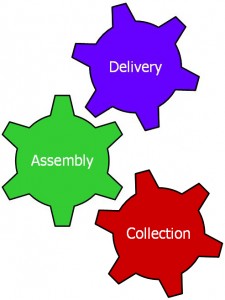When it comes to deploying a business intelligence solution, there are three integrated steps that you need to understand and implement to get the most out of your deployment:
- Collection: What data sources need to be joined?
- Assembly: What are the business rules defining how the data fits together?
- Delivery: Who should access information and how?
In this blog series, we will examine the different aspects to consider during each of the three steps to ensure you will glean the most meaningful insights from your BI implementation.
Step 1: Collection
Before you even start collecting your data, you should ask some questions about your source data to make sure you’re starting with the right information and parameters for your deployment.
- What data is needed to meet the information need?
- Where is the data located? If it comes from one source, you won’t have to worry so much about data integrity. However, if the data comes from disparate sources, you’ll need to ensure integrity, as the sources might not always match up. When it doesn’t match, how do you reconcile that?
- How will you access the data for extraction?
Once you have ensured that you have the right data from the right place and you know how it will be accessed, it’s time to start collection.
The first step in collection is to determine what data elements need to be combined. For example, we could have source data from an Oracle database, an SAP ERP system and Excel spreadsheets. Within many organizations, many business groups work in Excel. They often have an ERP system in place such as SAP, and their IT department may make an investment in additional technology, such as Oracle, to house data.
No one of these source systems stands totally alone; they share information such as customer numbers and product numbers. When you are thinking about combining information for business intelligence purposes, this is where you need a strong extraction, transformation and loading (ETL) tool.
As data is combined, it needs to be placed somewhere. It can either be stored in a data warehouse or it can be stored as a data mart.
Finally, it’s important to figure out whether the combined data will be used for other applications. You don’t want to have to combine data twice, so it’s imperative to identify multiple uses at the outset.
How Dimensional Insight Handles Data Collection
We have designed The Diver Solution (Diver) so that it has the flexibility to handle data from virtually any source system. Our ETL tool extracts data, aggregates and merges it, and applies business rules to create a highly indexed data structure optimized for ad hoc query, reporting, analytics and visualization. Our ad hoc query interface is a point and click interface that does not require SQL knowledge.
Some of our clients have as many as 20 different source systems that need to be combined; some have just one source system. This one system, though, could contain thousands of tables so there are multiple data extracts to satisfy needs.
Coming up next in this blog series, we’ll discuss the next two integrated steps of BI that you need to understand: data assembly and delivery.
Blog posts in this series:
- Step 1: Collection
- Step 2: Assembly
- Step 3: Delivery
- 3 Integrated Steps of Business Intelligence – Step 3: Delivery - April 10, 2014
- 3 Integrated Steps of Business Intelligence – Step 2: Assembly - April 2, 2014
- 3 Integrated Steps of Business Intelligence – Step 1: Collection - March 27, 2014


